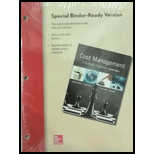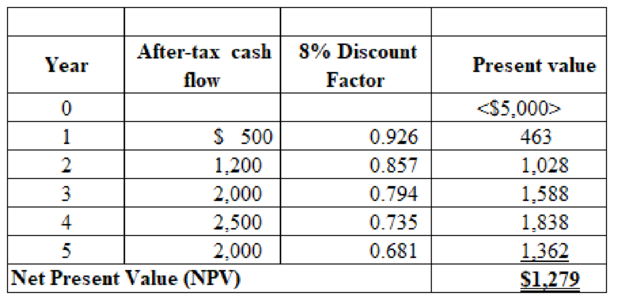
a.
Calculate the payback period of project A for the investment of $5,000 for five years.
a.
Explanation of Solution
Payback Period Method:
Payback period method is a method of capital investment analysis. This method is used to evaluate the investment opportunity on the basis of the time taken to recover the initial cost of investment in cash.
Calculate the payback period of project A for the investment of $5,000 for five years:
Therefore, the payback period of project A is 2.78 years.
b.
Calculate the payback period of project B for the investment of $5,000 for five years (assume that the cash inflows occur evenly throughout the year.
b.
Explanation of Solution
Calculate the payback period of project B for the investment of $5,000 for five years (assume that the cash inflows occur evenly throughout the year:
| After-tax | Cumulative | |
| Year | Cash Inflows | After-tax Inflows |
| 1 | $500 | $500 |
| 2 | $1,200 | $1,700 |
| 3 | $2,000 | $3,700 |
| 4 | $2,500 | $6,200 |
Table (1)
Therefore, the payback period of project B for the investment of $5,000 for five years is 3.52 years.
c.
Calculate the payback period of project C for the investment of $5,000 for five years.
c.
Explanation of Solution
Calculate the payback period of project C for the investment of $5,000 for five years:
Working notes:
Calculate the annual after-tax net
Step 1: Calculate the
Step 2: Calculate the taxable income for each year:
Step 3: Calculate the income tax for each year:
Step 4: Calculate the annual after-tax net cash inflow:
Therefore, the payback period of project C for the investment of $5,000 for five years is 2.35 years
d.(1)
Calculate the book
d.(1)
Explanation of Solution
Calculate the book rate of return based on the original investment.
Working notes:
Calculate the depreciation expense per year:
Calculate the operating income:
| Particulars | Amount ($) |
| Taxable Income: | |
| Sales | $4,000 |
| Expenses: | |
| Cash | $1,500 |
| Depreciation | $900 |
| Pre-tax Operating Income | $1,600 |
| Less: Income Taxes | $400 |
| Operating Income | $1,200 |
Table (2)
Therefore, the book rate of return based on the original investment is 24%.
d.(2)
Calculate the book rate of return based on the average book value.
d.(2)
Explanation of Solution
Calculate the book rate of return based on the average book value:
Working note:
Calculate the average book value:
Therefore, the book rate of return based on the average book value is 43.64%.
e.
Calculate the
e.
Explanation of Solution
Calculate the NPV of each project from A to D:
Project A:
Therefore, the NPV of project A is $2,187.4.
Project B:

Table (3)
Therefore, the NPV of project B is $1,279.
Project C:
Therefore, the NPV of project A is $3,485.
Project D:

Table (4)
Therefore, the NPV of project D is $3,726.
Want to see more full solutions like this?
Chapter 12 Solutions
COST MANAGEMENT (LOOSELEAF) >CUSTOM<

 AccountingAccountingISBN:9781337272094Author:WARREN, Carl S., Reeve, James M., Duchac, Jonathan E.Publisher:Cengage Learning,
AccountingAccountingISBN:9781337272094Author:WARREN, Carl S., Reeve, James M., Duchac, Jonathan E.Publisher:Cengage Learning, Accounting Information SystemsAccountingISBN:9781337619202Author:Hall, James A.Publisher:Cengage Learning,
Accounting Information SystemsAccountingISBN:9781337619202Author:Hall, James A.Publisher:Cengage Learning, Horngren's Cost Accounting: A Managerial Emphasis...AccountingISBN:9780134475585Author:Srikant M. Datar, Madhav V. RajanPublisher:PEARSON
Horngren's Cost Accounting: A Managerial Emphasis...AccountingISBN:9780134475585Author:Srikant M. Datar, Madhav V. RajanPublisher:PEARSON Intermediate AccountingAccountingISBN:9781259722660Author:J. David Spiceland, Mark W. Nelson, Wayne M ThomasPublisher:McGraw-Hill Education
Intermediate AccountingAccountingISBN:9781259722660Author:J. David Spiceland, Mark W. Nelson, Wayne M ThomasPublisher:McGraw-Hill Education Financial and Managerial AccountingAccountingISBN:9781259726705Author:John J Wild, Ken W. Shaw, Barbara Chiappetta Fundamental Accounting PrinciplesPublisher:McGraw-Hill Education
Financial and Managerial AccountingAccountingISBN:9781259726705Author:John J Wild, Ken W. Shaw, Barbara Chiappetta Fundamental Accounting PrinciplesPublisher:McGraw-Hill Education





